Climate Change Report 2022
VerifiedAdded on 2022/08/16
|11
|3505
|15
AI Summary
Contribute Materials
Your contribution can guide someone’s learning journey. Share your
documents today.
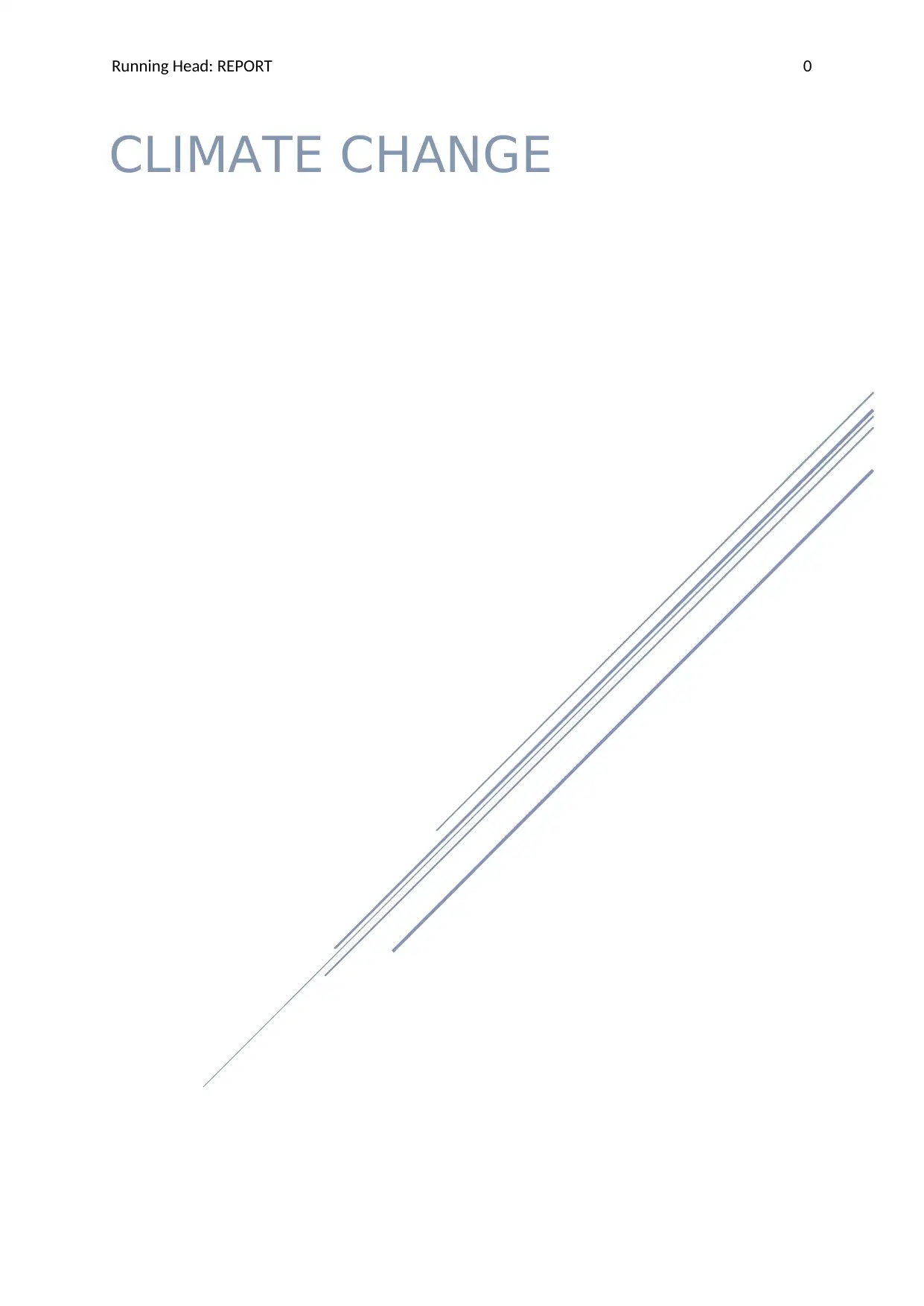
Running Head: REPORT 0
CLIMATE CHANGE
CLIMATE CHANGE
Secure Best Marks with AI Grader
Need help grading? Try our AI Grader for instant feedback on your assignments.
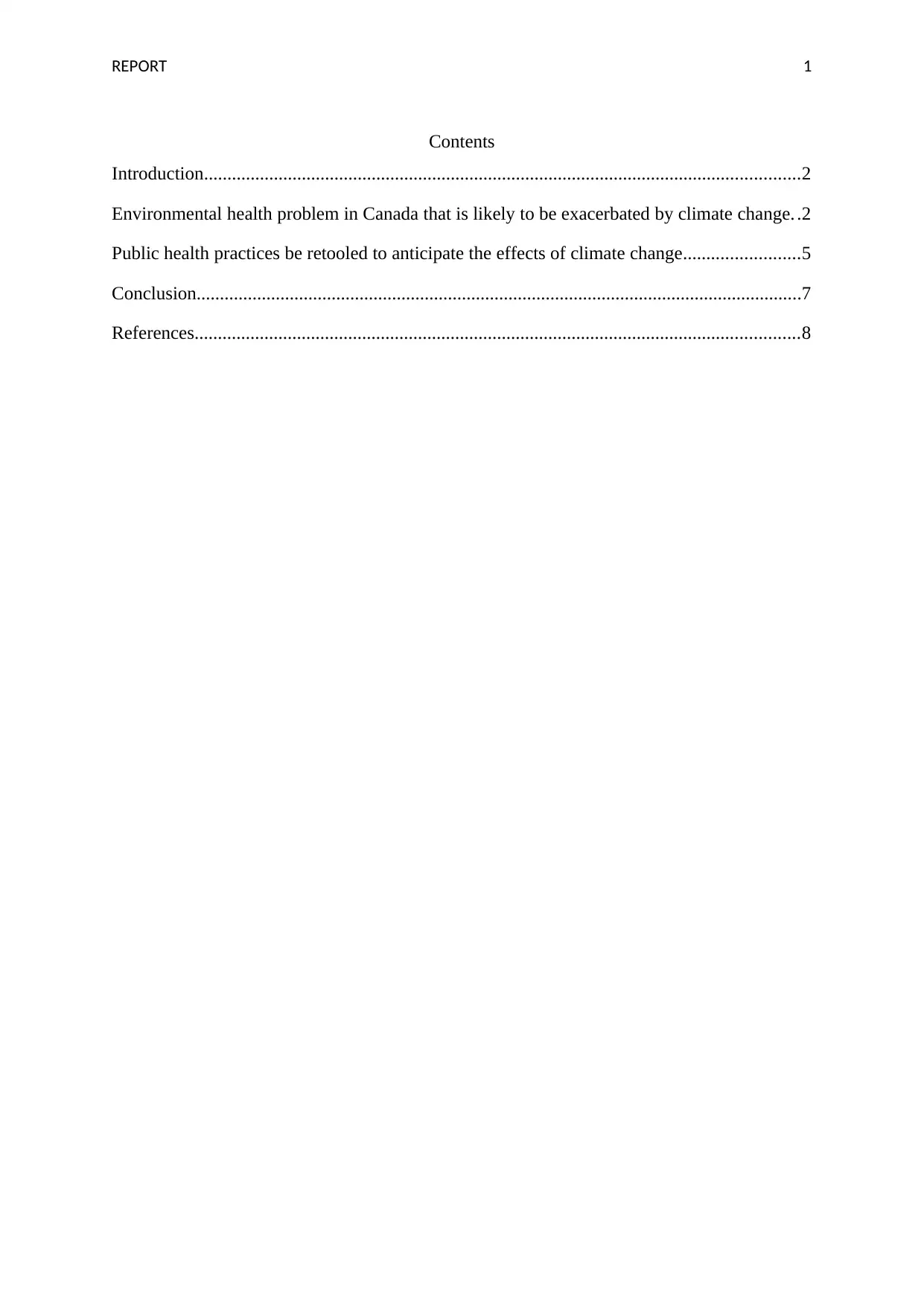
REPORT 1
Contents
Introduction................................................................................................................................2
Environmental health problem in Canada that is likely to be exacerbated by climate change. .2
Public health practices be retooled to anticipate the effects of climate change.........................5
Conclusion..................................................................................................................................7
References..................................................................................................................................8
Contents
Introduction................................................................................................................................2
Environmental health problem in Canada that is likely to be exacerbated by climate change. .2
Public health practices be retooled to anticipate the effects of climate change.........................5
Conclusion..................................................................................................................................7
References..................................................................................................................................8
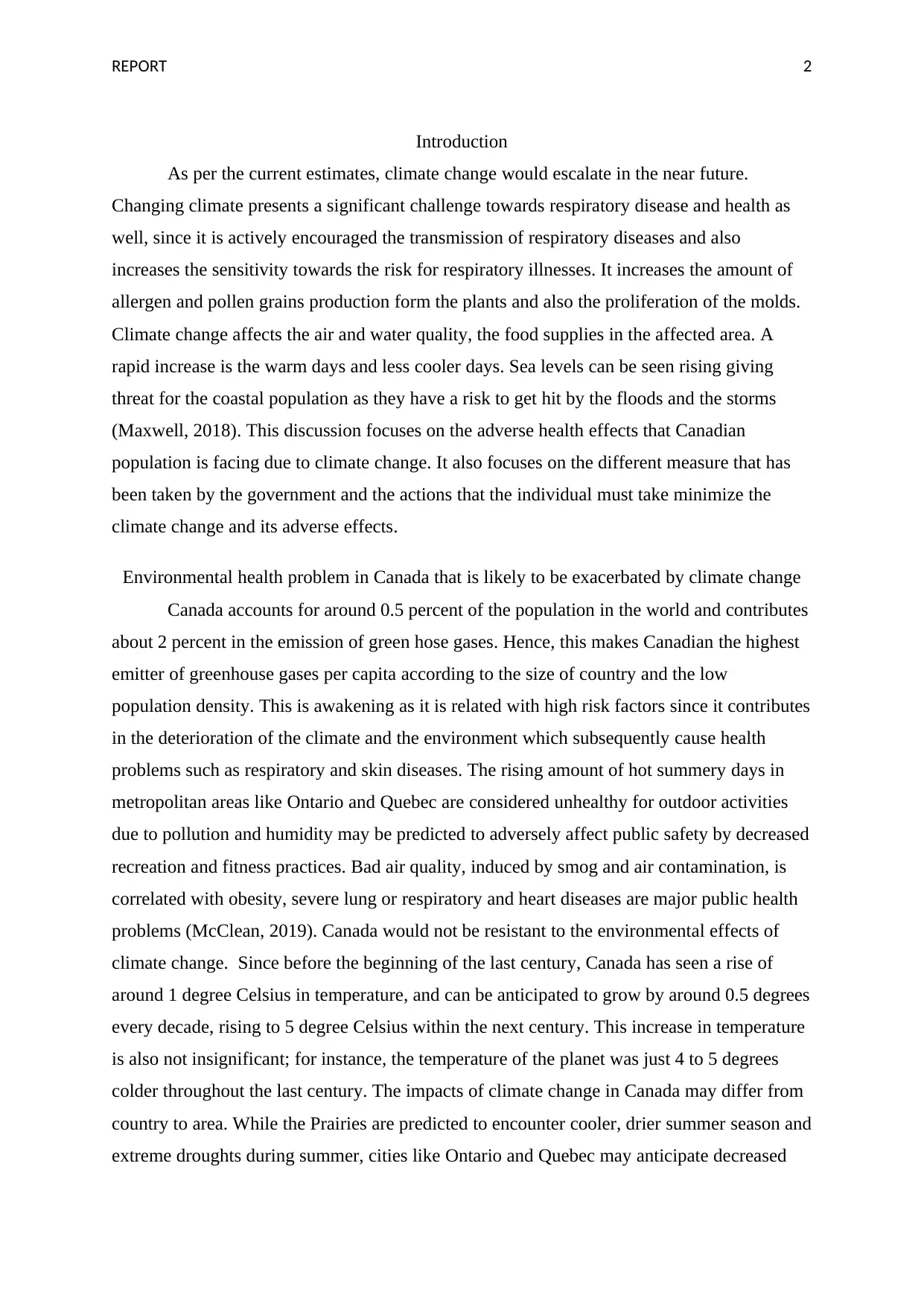
REPORT 2
Introduction
As per the current estimates, climate change would escalate in the near future.
Changing climate presents a significant challenge towards respiratory disease and health as
well, since it is actively encouraged the transmission of respiratory diseases and also
increases the sensitivity towards the risk for respiratory illnesses. It increases the amount of
allergen and pollen grains production form the plants and also the proliferation of the molds.
Climate change affects the air and water quality, the food supplies in the affected area. A
rapid increase is the warm days and less cooler days. Sea levels can be seen rising giving
threat for the coastal population as they have a risk to get hit by the floods and the storms
(Maxwell, 2018). This discussion focuses on the adverse health effects that Canadian
population is facing due to climate change. It also focuses on the different measure that has
been taken by the government and the actions that the individual must take minimize the
climate change and its adverse effects.
Environmental health problem in Canada that is likely to be exacerbated by climate change
Canada accounts for around 0.5 percent of the population in the world and contributes
about 2 percent in the emission of green hose gases. Hence, this makes Canadian the highest
emitter of greenhouse gases per capita according to the size of country and the low
population density. This is awakening as it is related with high risk factors since it contributes
in the deterioration of the climate and the environment which subsequently cause health
problems such as respiratory and skin diseases. The rising amount of hot summery days in
metropolitan areas like Ontario and Quebec are considered unhealthy for outdoor activities
due to pollution and humidity may be predicted to adversely affect public safety by decreased
recreation and fitness practices. Bad air quality, induced by smog and air contamination, is
correlated with obesity, severe lung or respiratory and heart diseases are major public health
problems (McClean, 2019). Canada would not be resistant to the environmental effects of
climate change. Since before the beginning of the last century, Canada has seen a rise of
around 1 degree Celsius in temperature, and can be anticipated to grow by around 0.5 degrees
every decade, rising to 5 degree Celsius within the next century. This increase in temperature
is also not insignificant; for instance, the temperature of the planet was just 4 to 5 degrees
colder throughout the last century. The impacts of climate change in Canada may differ from
country to area. While the Prairies are predicted to encounter cooler, drier summer season and
extreme droughts during summer, cities like Ontario and Quebec may anticipate decreased
Introduction
As per the current estimates, climate change would escalate in the near future.
Changing climate presents a significant challenge towards respiratory disease and health as
well, since it is actively encouraged the transmission of respiratory diseases and also
increases the sensitivity towards the risk for respiratory illnesses. It increases the amount of
allergen and pollen grains production form the plants and also the proliferation of the molds.
Climate change affects the air and water quality, the food supplies in the affected area. A
rapid increase is the warm days and less cooler days. Sea levels can be seen rising giving
threat for the coastal population as they have a risk to get hit by the floods and the storms
(Maxwell, 2018). This discussion focuses on the adverse health effects that Canadian
population is facing due to climate change. It also focuses on the different measure that has
been taken by the government and the actions that the individual must take minimize the
climate change and its adverse effects.
Environmental health problem in Canada that is likely to be exacerbated by climate change
Canada accounts for around 0.5 percent of the population in the world and contributes
about 2 percent in the emission of green hose gases. Hence, this makes Canadian the highest
emitter of greenhouse gases per capita according to the size of country and the low
population density. This is awakening as it is related with high risk factors since it contributes
in the deterioration of the climate and the environment which subsequently cause health
problems such as respiratory and skin diseases. The rising amount of hot summery days in
metropolitan areas like Ontario and Quebec are considered unhealthy for outdoor activities
due to pollution and humidity may be predicted to adversely affect public safety by decreased
recreation and fitness practices. Bad air quality, induced by smog and air contamination, is
correlated with obesity, severe lung or respiratory and heart diseases are major public health
problems (McClean, 2019). Canada would not be resistant to the environmental effects of
climate change. Since before the beginning of the last century, Canada has seen a rise of
around 1 degree Celsius in temperature, and can be anticipated to grow by around 0.5 degrees
every decade, rising to 5 degree Celsius within the next century. This increase in temperature
is also not insignificant; for instance, the temperature of the planet was just 4 to 5 degrees
colder throughout the last century. The impacts of climate change in Canada may differ from
country to area. While the Prairies are predicted to encounter cooler, drier summer season and
extreme droughts during summer, cities like Ontario and Quebec may anticipate decreased
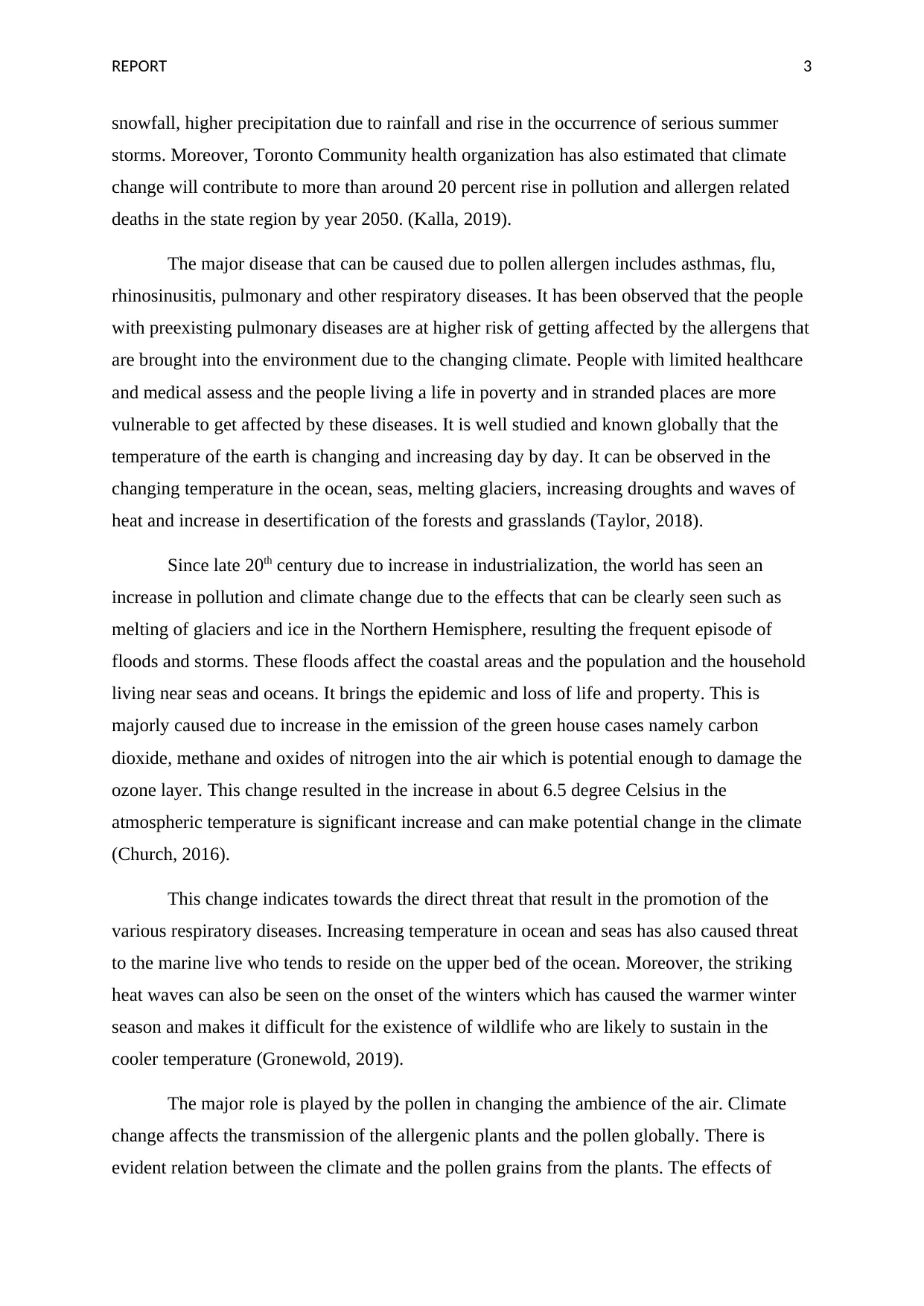
REPORT 3
snowfall, higher precipitation due to rainfall and rise in the occurrence of serious summer
storms. Moreover, Toronto Community health organization has also estimated that climate
change will contribute to more than around 20 percent rise in pollution and allergen related
deaths in the state region by year 2050. (Kalla, 2019).
The major disease that can be caused due to pollen allergen includes asthmas, flu,
rhinosinusitis, pulmonary and other respiratory diseases. It has been observed that the people
with preexisting pulmonary diseases are at higher risk of getting affected by the allergens that
are brought into the environment due to the changing climate. People with limited healthcare
and medical assess and the people living a life in poverty and in stranded places are more
vulnerable to get affected by these diseases. It is well studied and known globally that the
temperature of the earth is changing and increasing day by day. It can be observed in the
changing temperature in the ocean, seas, melting glaciers, increasing droughts and waves of
heat and increase in desertification of the forests and grasslands (Taylor, 2018).
Since late 20th century due to increase in industrialization, the world has seen an
increase in pollution and climate change due to the effects that can be clearly seen such as
melting of glaciers and ice in the Northern Hemisphere, resulting the frequent episode of
floods and storms. These floods affect the coastal areas and the population and the household
living near seas and oceans. It brings the epidemic and loss of life and property. This is
majorly caused due to increase in the emission of the green house cases namely carbon
dioxide, methane and oxides of nitrogen into the air which is potential enough to damage the
ozone layer. This change resulted in the increase in about 6.5 degree Celsius in the
atmospheric temperature is significant increase and can make potential change in the climate
(Church, 2016).
This change indicates towards the direct threat that result in the promotion of the
various respiratory diseases. Increasing temperature in ocean and seas has also caused threat
to the marine live who tends to reside on the upper bed of the ocean. Moreover, the striking
heat waves can also be seen on the onset of the winters which has caused the warmer winter
season and makes it difficult for the existence of wildlife who are likely to sustain in the
cooler temperature (Gronewold, 2019).
The major role is played by the pollen in changing the ambience of the air. Climate
change affects the transmission of the allergenic plants and the pollen globally. There is
evident relation between the climate and the pollen grains from the plants. The effects of
snowfall, higher precipitation due to rainfall and rise in the occurrence of serious summer
storms. Moreover, Toronto Community health organization has also estimated that climate
change will contribute to more than around 20 percent rise in pollution and allergen related
deaths in the state region by year 2050. (Kalla, 2019).
The major disease that can be caused due to pollen allergen includes asthmas, flu,
rhinosinusitis, pulmonary and other respiratory diseases. It has been observed that the people
with preexisting pulmonary diseases are at higher risk of getting affected by the allergens that
are brought into the environment due to the changing climate. People with limited healthcare
and medical assess and the people living a life in poverty and in stranded places are more
vulnerable to get affected by these diseases. It is well studied and known globally that the
temperature of the earth is changing and increasing day by day. It can be observed in the
changing temperature in the ocean, seas, melting glaciers, increasing droughts and waves of
heat and increase in desertification of the forests and grasslands (Taylor, 2018).
Since late 20th century due to increase in industrialization, the world has seen an
increase in pollution and climate change due to the effects that can be clearly seen such as
melting of glaciers and ice in the Northern Hemisphere, resulting the frequent episode of
floods and storms. These floods affect the coastal areas and the population and the household
living near seas and oceans. It brings the epidemic and loss of life and property. This is
majorly caused due to increase in the emission of the green house cases namely carbon
dioxide, methane and oxides of nitrogen into the air which is potential enough to damage the
ozone layer. This change resulted in the increase in about 6.5 degree Celsius in the
atmospheric temperature is significant increase and can make potential change in the climate
(Church, 2016).
This change indicates towards the direct threat that result in the promotion of the
various respiratory diseases. Increasing temperature in ocean and seas has also caused threat
to the marine live who tends to reside on the upper bed of the ocean. Moreover, the striking
heat waves can also be seen on the onset of the winters which has caused the warmer winter
season and makes it difficult for the existence of wildlife who are likely to sustain in the
cooler temperature (Gronewold, 2019).
The major role is played by the pollen in changing the ambience of the air. Climate
change affects the transmission of the allergenic plants and the pollen globally. There is
evident relation between the climate and the pollen grains from the plants. The effects of
Secure Best Marks with AI Grader
Need help grading? Try our AI Grader for instant feedback on your assignments.
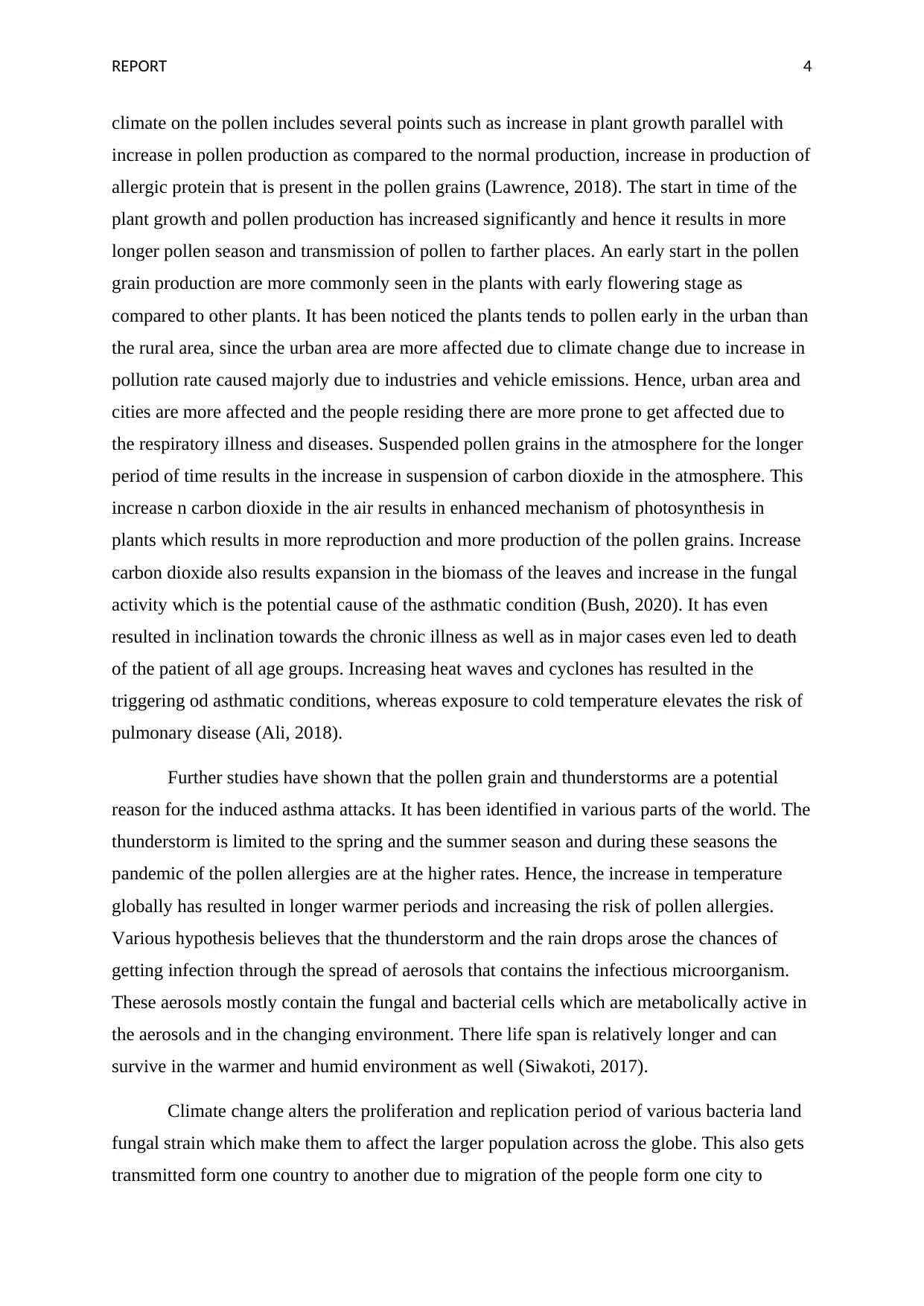
REPORT 4
climate on the pollen includes several points such as increase in plant growth parallel with
increase in pollen production as compared to the normal production, increase in production of
allergic protein that is present in the pollen grains (Lawrence, 2018). The start in time of the
plant growth and pollen production has increased significantly and hence it results in more
longer pollen season and transmission of pollen to farther places. An early start in the pollen
grain production are more commonly seen in the plants with early flowering stage as
compared to other plants. It has been noticed the plants tends to pollen early in the urban than
the rural area, since the urban area are more affected due to climate change due to increase in
pollution rate caused majorly due to industries and vehicle emissions. Hence, urban area and
cities are more affected and the people residing there are more prone to get affected due to
the respiratory illness and diseases. Suspended pollen grains in the atmosphere for the longer
period of time results in the increase in suspension of carbon dioxide in the atmosphere. This
increase n carbon dioxide in the air results in enhanced mechanism of photosynthesis in
plants which results in more reproduction and more production of the pollen grains. Increase
carbon dioxide also results expansion in the biomass of the leaves and increase in the fungal
activity which is the potential cause of the asthmatic condition (Bush, 2020). It has even
resulted in inclination towards the chronic illness as well as in major cases even led to death
of the patient of all age groups. Increasing heat waves and cyclones has resulted in the
triggering od asthmatic conditions, whereas exposure to cold temperature elevates the risk of
pulmonary disease (Ali, 2018).
Further studies have shown that the pollen grain and thunderstorms are a potential
reason for the induced asthma attacks. It has been identified in various parts of the world. The
thunderstorm is limited to the spring and the summer season and during these seasons the
pandemic of the pollen allergies are at the higher rates. Hence, the increase in temperature
globally has resulted in longer warmer periods and increasing the risk of pollen allergies.
Various hypothesis believes that the thunderstorm and the rain drops arose the chances of
getting infection through the spread of aerosols that contains the infectious microorganism.
These aerosols mostly contain the fungal and bacterial cells which are metabolically active in
the aerosols and in the changing environment. There life span is relatively longer and can
survive in the warmer and humid environment as well (Siwakoti, 2017).
Climate change alters the proliferation and replication period of various bacteria land
fungal strain which make them to affect the larger population across the globe. This also gets
transmitted form one country to another due to migration of the people form one city to
climate on the pollen includes several points such as increase in plant growth parallel with
increase in pollen production as compared to the normal production, increase in production of
allergic protein that is present in the pollen grains (Lawrence, 2018). The start in time of the
plant growth and pollen production has increased significantly and hence it results in more
longer pollen season and transmission of pollen to farther places. An early start in the pollen
grain production are more commonly seen in the plants with early flowering stage as
compared to other plants. It has been noticed the plants tends to pollen early in the urban than
the rural area, since the urban area are more affected due to climate change due to increase in
pollution rate caused majorly due to industries and vehicle emissions. Hence, urban area and
cities are more affected and the people residing there are more prone to get affected due to
the respiratory illness and diseases. Suspended pollen grains in the atmosphere for the longer
period of time results in the increase in suspension of carbon dioxide in the atmosphere. This
increase n carbon dioxide in the air results in enhanced mechanism of photosynthesis in
plants which results in more reproduction and more production of the pollen grains. Increase
carbon dioxide also results expansion in the biomass of the leaves and increase in the fungal
activity which is the potential cause of the asthmatic condition (Bush, 2020). It has even
resulted in inclination towards the chronic illness as well as in major cases even led to death
of the patient of all age groups. Increasing heat waves and cyclones has resulted in the
triggering od asthmatic conditions, whereas exposure to cold temperature elevates the risk of
pulmonary disease (Ali, 2018).
Further studies have shown that the pollen grain and thunderstorms are a potential
reason for the induced asthma attacks. It has been identified in various parts of the world. The
thunderstorm is limited to the spring and the summer season and during these seasons the
pandemic of the pollen allergies are at the higher rates. Hence, the increase in temperature
globally has resulted in longer warmer periods and increasing the risk of pollen allergies.
Various hypothesis believes that the thunderstorm and the rain drops arose the chances of
getting infection through the spread of aerosols that contains the infectious microorganism.
These aerosols mostly contain the fungal and bacterial cells which are metabolically active in
the aerosols and in the changing environment. There life span is relatively longer and can
survive in the warmer and humid environment as well (Siwakoti, 2017).
Climate change alters the proliferation and replication period of various bacteria land
fungal strain which make them to affect the larger population across the globe. This also gets
transmitted form one country to another due to migration of the people form one city to
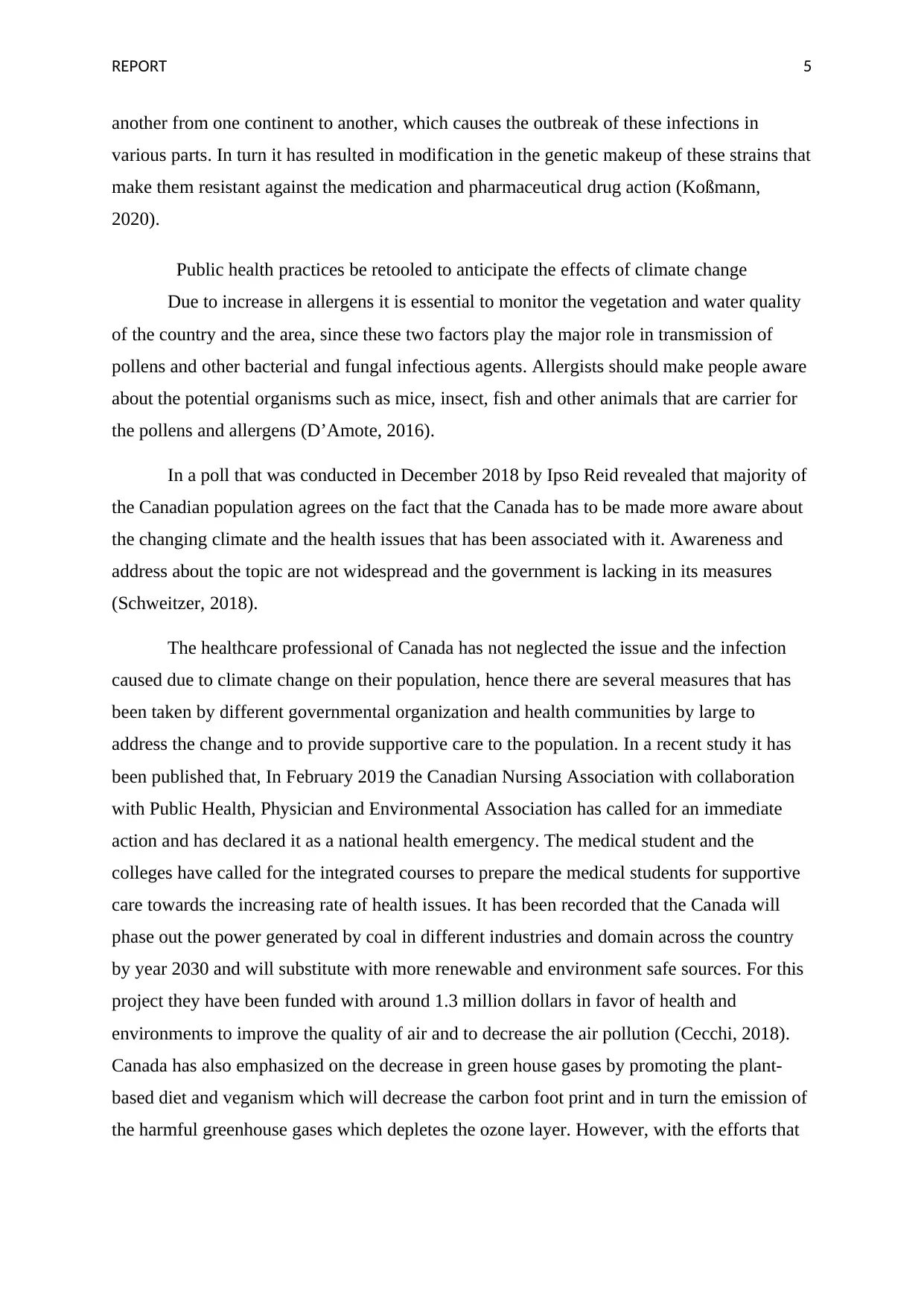
REPORT 5
another from one continent to another, which causes the outbreak of these infections in
various parts. In turn it has resulted in modification in the genetic makeup of these strains that
make them resistant against the medication and pharmaceutical drug action (Koßmann,
2020).
Public health practices be retooled to anticipate the effects of climate change
Due to increase in allergens it is essential to monitor the vegetation and water quality
of the country and the area, since these two factors play the major role in transmission of
pollens and other bacterial and fungal infectious agents. Allergists should make people aware
about the potential organisms such as mice, insect, fish and other animals that are carrier for
the pollens and allergens (D’Amote, 2016).
In a poll that was conducted in December 2018 by Ipso Reid revealed that majority of
the Canadian population agrees on the fact that the Canada has to be made more aware about
the changing climate and the health issues that has been associated with it. Awareness and
address about the topic are not widespread and the government is lacking in its measures
(Schweitzer, 2018).
The healthcare professional of Canada has not neglected the issue and the infection
caused due to climate change on their population, hence there are several measures that has
been taken by different governmental organization and health communities by large to
address the change and to provide supportive care to the population. In a recent study it has
been published that, In February 2019 the Canadian Nursing Association with collaboration
with Public Health, Physician and Environmental Association has called for an immediate
action and has declared it as a national health emergency. The medical student and the
colleges have called for the integrated courses to prepare the medical students for supportive
care towards the increasing rate of health issues. It has been recorded that the Canada will
phase out the power generated by coal in different industries and domain across the country
by year 2030 and will substitute with more renewable and environment safe sources. For this
project they have been funded with around 1.3 million dollars in favor of health and
environments to improve the quality of air and to decrease the air pollution (Cecchi, 2018).
Canada has also emphasized on the decrease in green house gases by promoting the plant-
based diet and veganism which will decrease the carbon foot print and in turn the emission of
the harmful greenhouse gases which depletes the ozone layer. However, with the efforts that
another from one continent to another, which causes the outbreak of these infections in
various parts. In turn it has resulted in modification in the genetic makeup of these strains that
make them resistant against the medication and pharmaceutical drug action (Koßmann,
2020).
Public health practices be retooled to anticipate the effects of climate change
Due to increase in allergens it is essential to monitor the vegetation and water quality
of the country and the area, since these two factors play the major role in transmission of
pollens and other bacterial and fungal infectious agents. Allergists should make people aware
about the potential organisms such as mice, insect, fish and other animals that are carrier for
the pollens and allergens (D’Amote, 2016).
In a poll that was conducted in December 2018 by Ipso Reid revealed that majority of
the Canadian population agrees on the fact that the Canada has to be made more aware about
the changing climate and the health issues that has been associated with it. Awareness and
address about the topic are not widespread and the government is lacking in its measures
(Schweitzer, 2018).
The healthcare professional of Canada has not neglected the issue and the infection
caused due to climate change on their population, hence there are several measures that has
been taken by different governmental organization and health communities by large to
address the change and to provide supportive care to the population. In a recent study it has
been published that, In February 2019 the Canadian Nursing Association with collaboration
with Public Health, Physician and Environmental Association has called for an immediate
action and has declared it as a national health emergency. The medical student and the
colleges have called for the integrated courses to prepare the medical students for supportive
care towards the increasing rate of health issues. It has been recorded that the Canada will
phase out the power generated by coal in different industries and domain across the country
by year 2030 and will substitute with more renewable and environment safe sources. For this
project they have been funded with around 1.3 million dollars in favor of health and
environments to improve the quality of air and to decrease the air pollution (Cecchi, 2018).
Canada has also emphasized on the decrease in green house gases by promoting the plant-
based diet and veganism which will decrease the carbon foot print and in turn the emission of
the harmful greenhouse gases which depletes the ozone layer. However, with the efforts that
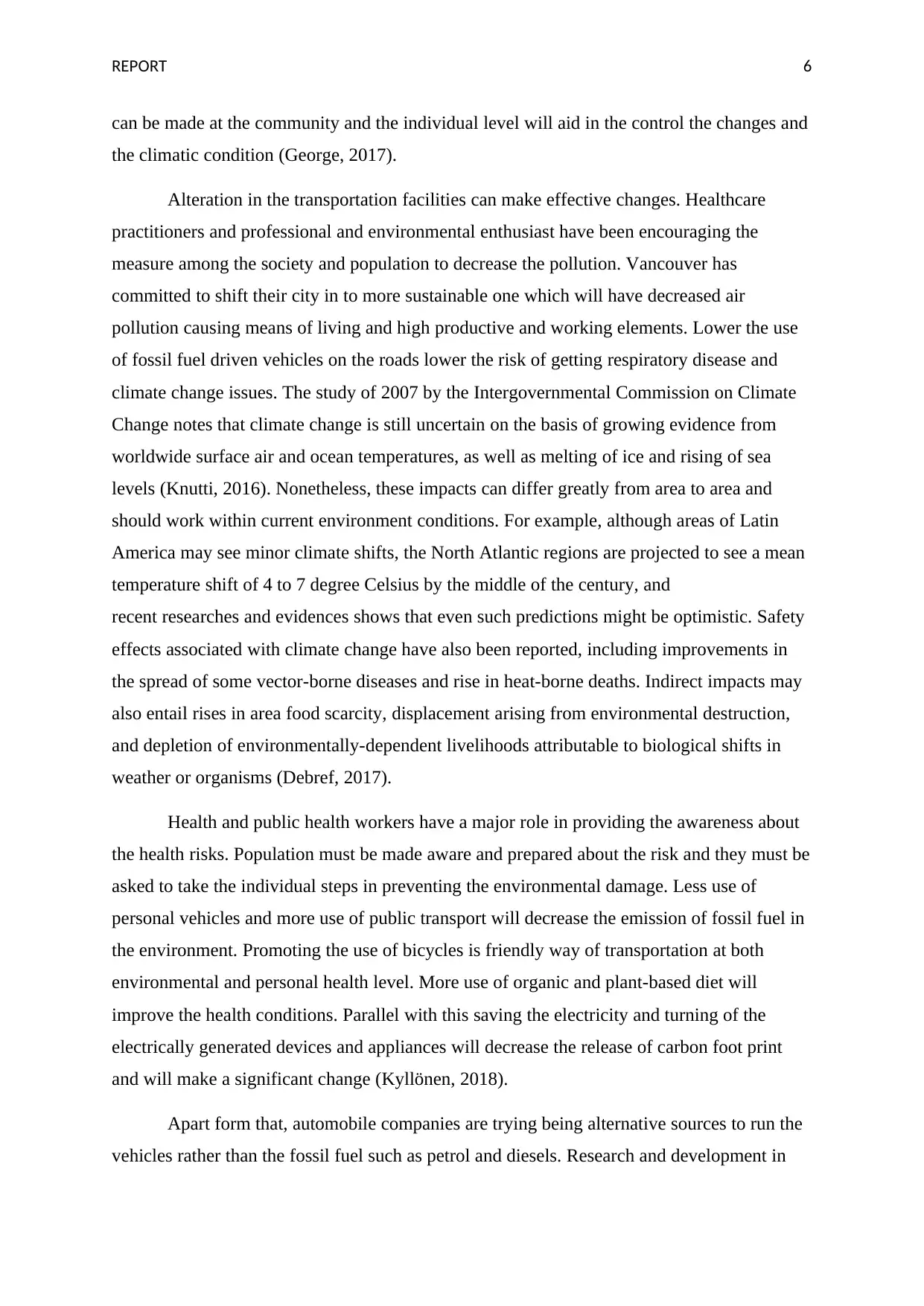
REPORT 6
can be made at the community and the individual level will aid in the control the changes and
the climatic condition (George, 2017).
Alteration in the transportation facilities can make effective changes. Healthcare
practitioners and professional and environmental enthusiast have been encouraging the
measure among the society and population to decrease the pollution. Vancouver has
committed to shift their city in to more sustainable one which will have decreased air
pollution causing means of living and high productive and working elements. Lower the use
of fossil fuel driven vehicles on the roads lower the risk of getting respiratory disease and
climate change issues. The study of 2007 by the Intergovernmental Commission on Climate
Change notes that climate change is still uncertain on the basis of growing evidence from
worldwide surface air and ocean temperatures, as well as melting of ice and rising of sea
levels (Knutti, 2016). Nonetheless, these impacts can differ greatly from area to area and
should work within current environment conditions. For example, although areas of Latin
America may see minor climate shifts, the North Atlantic regions are projected to see a mean
temperature shift of 4 to 7 degree Celsius by the middle of the century, and
recent researches and evidences shows that even such predictions might be optimistic. Safety
effects associated with climate change have also been reported, including improvements in
the spread of some vector-borne diseases and rise in heat-borne deaths. Indirect impacts may
also entail rises in area food scarcity, displacement arising from environmental destruction,
and depletion of environmentally-dependent livelihoods attributable to biological shifts in
weather or organisms (Debref, 2017).
Health and public health workers have a major role in providing the awareness about
the health risks. Population must be made aware and prepared about the risk and they must be
asked to take the individual steps in preventing the environmental damage. Less use of
personal vehicles and more use of public transport will decrease the emission of fossil fuel in
the environment. Promoting the use of bicycles is friendly way of transportation at both
environmental and personal health level. More use of organic and plant-based diet will
improve the health conditions. Parallel with this saving the electricity and turning of the
electrically generated devices and appliances will decrease the release of carbon foot print
and will make a significant change (Kyllönen, 2018).
Apart form that, automobile companies are trying being alternative sources to run the
vehicles rather than the fossil fuel such as petrol and diesels. Research and development in
can be made at the community and the individual level will aid in the control the changes and
the climatic condition (George, 2017).
Alteration in the transportation facilities can make effective changes. Healthcare
practitioners and professional and environmental enthusiast have been encouraging the
measure among the society and population to decrease the pollution. Vancouver has
committed to shift their city in to more sustainable one which will have decreased air
pollution causing means of living and high productive and working elements. Lower the use
of fossil fuel driven vehicles on the roads lower the risk of getting respiratory disease and
climate change issues. The study of 2007 by the Intergovernmental Commission on Climate
Change notes that climate change is still uncertain on the basis of growing evidence from
worldwide surface air and ocean temperatures, as well as melting of ice and rising of sea
levels (Knutti, 2016). Nonetheless, these impacts can differ greatly from area to area and
should work within current environment conditions. For example, although areas of Latin
America may see minor climate shifts, the North Atlantic regions are projected to see a mean
temperature shift of 4 to 7 degree Celsius by the middle of the century, and
recent researches and evidences shows that even such predictions might be optimistic. Safety
effects associated with climate change have also been reported, including improvements in
the spread of some vector-borne diseases and rise in heat-borne deaths. Indirect impacts may
also entail rises in area food scarcity, displacement arising from environmental destruction,
and depletion of environmentally-dependent livelihoods attributable to biological shifts in
weather or organisms (Debref, 2017).
Health and public health workers have a major role in providing the awareness about
the health risks. Population must be made aware and prepared about the risk and they must be
asked to take the individual steps in preventing the environmental damage. Less use of
personal vehicles and more use of public transport will decrease the emission of fossil fuel in
the environment. Promoting the use of bicycles is friendly way of transportation at both
environmental and personal health level. More use of organic and plant-based diet will
improve the health conditions. Parallel with this saving the electricity and turning of the
electrically generated devices and appliances will decrease the release of carbon foot print
and will make a significant change (Kyllönen, 2018).
Apart form that, automobile companies are trying being alternative sources to run the
vehicles rather than the fossil fuel such as petrol and diesels. Research and development in
Paraphrase This Document
Need a fresh take? Get an instant paraphrase of this document with our AI Paraphraser
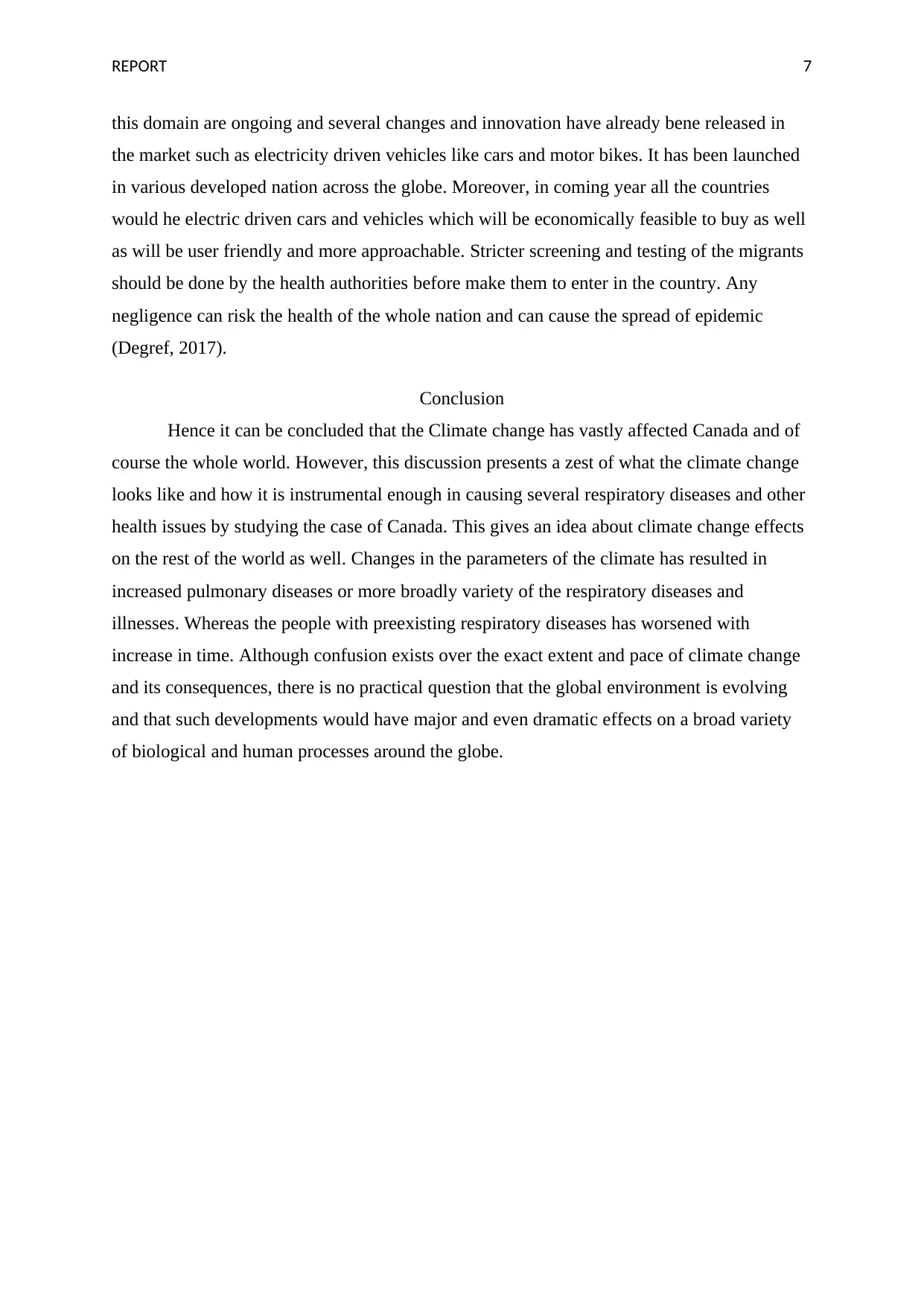
REPORT 7
this domain are ongoing and several changes and innovation have already bene released in
the market such as electricity driven vehicles like cars and motor bikes. It has been launched
in various developed nation across the globe. Moreover, in coming year all the countries
would he electric driven cars and vehicles which will be economically feasible to buy as well
as will be user friendly and more approachable. Stricter screening and testing of the migrants
should be done by the health authorities before make them to enter in the country. Any
negligence can risk the health of the whole nation and can cause the spread of epidemic
(Degref, 2017).
Conclusion
Hence it can be concluded that the Climate change has vastly affected Canada and of
course the whole world. However, this discussion presents a zest of what the climate change
looks like and how it is instrumental enough in causing several respiratory diseases and other
health issues by studying the case of Canada. This gives an idea about climate change effects
on the rest of the world as well. Changes in the parameters of the climate has resulted in
increased pulmonary diseases or more broadly variety of the respiratory diseases and
illnesses. Whereas the people with preexisting respiratory diseases has worsened with
increase in time. Although confusion exists over the exact extent and pace of climate change
and its consequences, there is no practical question that the global environment is evolving
and that such developments would have major and even dramatic effects on a broad variety
of biological and human processes around the globe.
this domain are ongoing and several changes and innovation have already bene released in
the market such as electricity driven vehicles like cars and motor bikes. It has been launched
in various developed nation across the globe. Moreover, in coming year all the countries
would he electric driven cars and vehicles which will be economically feasible to buy as well
as will be user friendly and more approachable. Stricter screening and testing of the migrants
should be done by the health authorities before make them to enter in the country. Any
negligence can risk the health of the whole nation and can cause the spread of epidemic
(Degref, 2017).
Conclusion
Hence it can be concluded that the Climate change has vastly affected Canada and of
course the whole world. However, this discussion presents a zest of what the climate change
looks like and how it is instrumental enough in causing several respiratory diseases and other
health issues by studying the case of Canada. This gives an idea about climate change effects
on the rest of the world as well. Changes in the parameters of the climate has resulted in
increased pulmonary diseases or more broadly variety of the respiratory diseases and
illnesses. Whereas the people with preexisting respiratory diseases has worsened with
increase in time. Although confusion exists over the exact extent and pace of climate change
and its consequences, there is no practical question that the global environment is evolving
and that such developments would have major and even dramatic effects on a broad variety
of biological and human processes around the globe.
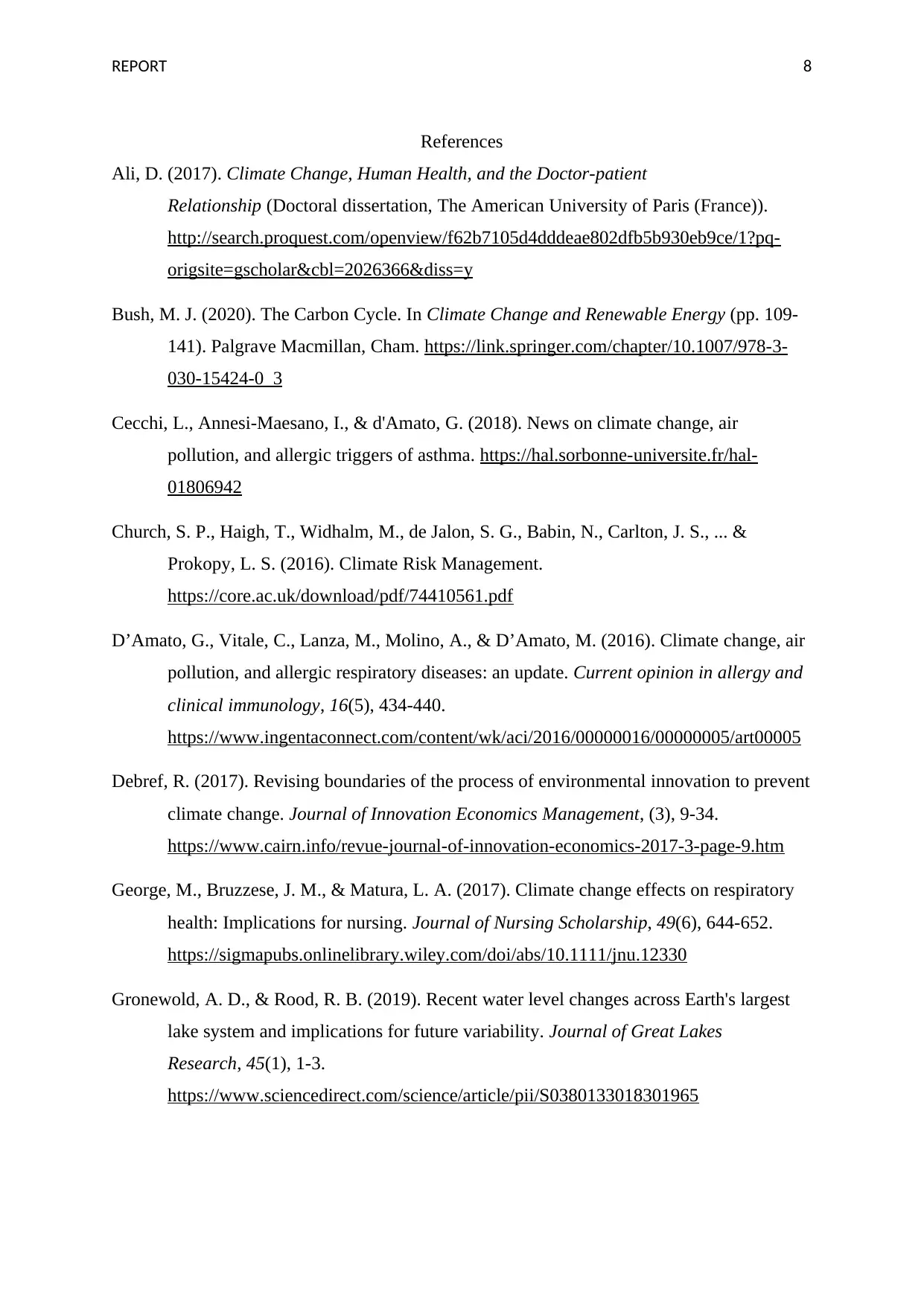
REPORT 8
References
Ali, D. (2017). Climate Change, Human Health, and the Doctor-patient
Relationship (Doctoral dissertation, The American University of Paris (France)).
http://search.proquest.com/openview/f62b7105d4dddeae802dfb5b930eb9ce/1?pq-
origsite=gscholar&cbl=2026366&diss=y
Bush, M. J. (2020). The Carbon Cycle. In Climate Change and Renewable Energy (pp. 109-
141). Palgrave Macmillan, Cham. https://link.springer.com/chapter/10.1007/978-3-
030-15424-0_3
Cecchi, L., Annesi-Maesano, I., & d'Amato, G. (2018). News on climate change, air
pollution, and allergic triggers of asthma. https://hal.sorbonne-universite.fr/hal-
01806942
Church, S. P., Haigh, T., Widhalm, M., de Jalon, S. G., Babin, N., Carlton, J. S., ... &
Prokopy, L. S. (2016). Climate Risk Management.
https://core.ac.uk/download/pdf/74410561.pdf
D’Amato, G., Vitale, C., Lanza, M., Molino, A., & D’Amato, M. (2016). Climate change, air
pollution, and allergic respiratory diseases: an update. Current opinion in allergy and
clinical immunology, 16(5), 434-440.
https://www.ingentaconnect.com/content/wk/aci/2016/00000016/00000005/art00005
Debref, R. (2017). Revising boundaries of the process of environmental innovation to prevent
climate change. Journal of Innovation Economics Management, (3), 9-34.
https://www.cairn.info/revue-journal-of-innovation-economics-2017-3-page-9.htm
George, M., Bruzzese, J. M., & Matura, L. A. (2017). Climate change effects on respiratory
health: Implications for nursing. Journal of Nursing Scholarship, 49(6), 644-652.
https://sigmapubs.onlinelibrary.wiley.com/doi/abs/10.1111/jnu.12330
Gronewold, A. D., & Rood, R. B. (2019). Recent water level changes across Earth's largest
lake system and implications for future variability. Journal of Great Lakes
Research, 45(1), 1-3.
https://www.sciencedirect.com/science/article/pii/S0380133018301965
References
Ali, D. (2017). Climate Change, Human Health, and the Doctor-patient
Relationship (Doctoral dissertation, The American University of Paris (France)).
http://search.proquest.com/openview/f62b7105d4dddeae802dfb5b930eb9ce/1?pq-
origsite=gscholar&cbl=2026366&diss=y
Bush, M. J. (2020). The Carbon Cycle. In Climate Change and Renewable Energy (pp. 109-
141). Palgrave Macmillan, Cham. https://link.springer.com/chapter/10.1007/978-3-
030-15424-0_3
Cecchi, L., Annesi-Maesano, I., & d'Amato, G. (2018). News on climate change, air
pollution, and allergic triggers of asthma. https://hal.sorbonne-universite.fr/hal-
01806942
Church, S. P., Haigh, T., Widhalm, M., de Jalon, S. G., Babin, N., Carlton, J. S., ... &
Prokopy, L. S. (2016). Climate Risk Management.
https://core.ac.uk/download/pdf/74410561.pdf
D’Amato, G., Vitale, C., Lanza, M., Molino, A., & D’Amato, M. (2016). Climate change, air
pollution, and allergic respiratory diseases: an update. Current opinion in allergy and
clinical immunology, 16(5), 434-440.
https://www.ingentaconnect.com/content/wk/aci/2016/00000016/00000005/art00005
Debref, R. (2017). Revising boundaries of the process of environmental innovation to prevent
climate change. Journal of Innovation Economics Management, (3), 9-34.
https://www.cairn.info/revue-journal-of-innovation-economics-2017-3-page-9.htm
George, M., Bruzzese, J. M., & Matura, L. A. (2017). Climate change effects on respiratory
health: Implications for nursing. Journal of Nursing Scholarship, 49(6), 644-652.
https://sigmapubs.onlinelibrary.wiley.com/doi/abs/10.1111/jnu.12330
Gronewold, A. D., & Rood, R. B. (2019). Recent water level changes across Earth's largest
lake system and implications for future variability. Journal of Great Lakes
Research, 45(1), 1-3.
https://www.sciencedirect.com/science/article/pii/S0380133018301965
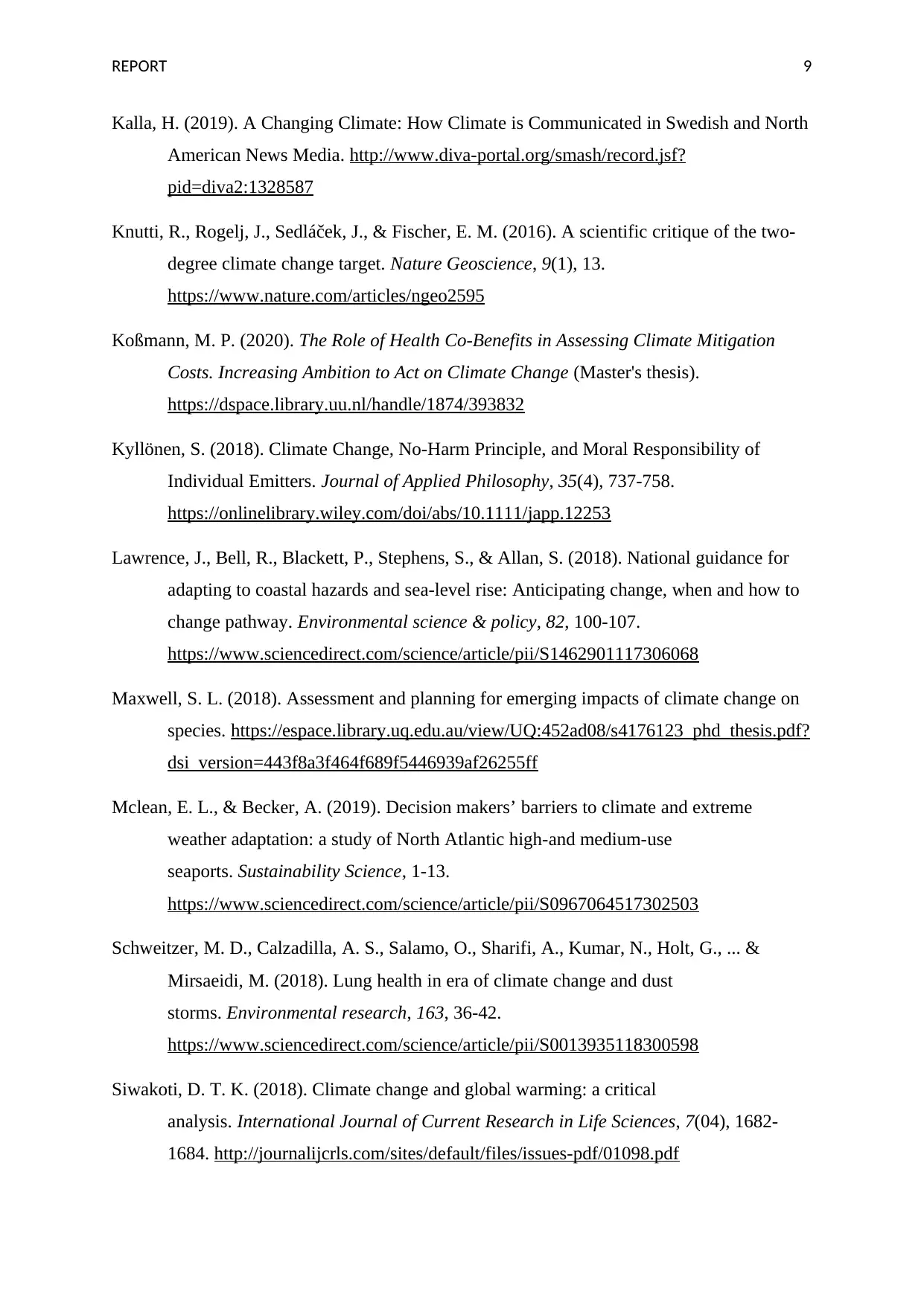
REPORT 9
Kalla, H. (2019). A Changing Climate: How Climate is Communicated in Swedish and North
American News Media. http://www.diva-portal.org/smash/record.jsf?
pid=diva2:1328587
Knutti, R., Rogelj, J., Sedláček, J., & Fischer, E. M. (2016). A scientific critique of the two-
degree climate change target. Nature Geoscience, 9(1), 13.
https://www.nature.com/articles/ngeo2595
Koßmann, M. P. (2020). The Role of Health Co-Benefits in Assessing Climate Mitigation
Costs. Increasing Ambition to Act on Climate Change (Master's thesis).
https://dspace.library.uu.nl/handle/1874/393832
Kyllönen, S. (2018). Climate Change, No‐Harm Principle, and Moral Responsibility of
Individual Emitters. Journal of Applied Philosophy, 35(4), 737-758.
https://onlinelibrary.wiley.com/doi/abs/10.1111/japp.12253
Lawrence, J., Bell, R., Blackett, P., Stephens, S., & Allan, S. (2018). National guidance for
adapting to coastal hazards and sea-level rise: Anticipating change, when and how to
change pathway. Environmental science & policy, 82, 100-107.
https://www.sciencedirect.com/science/article/pii/S1462901117306068
Maxwell, S. L. (2018). Assessment and planning for emerging impacts of climate change on
species. https://espace.library.uq.edu.au/view/UQ:452ad08/s4176123_phd_thesis.pdf?
dsi_version=443f8a3f464f689f5446939af26255ff
Mclean, E. L., & Becker, A. (2019). Decision makers’ barriers to climate and extreme
weather adaptation: a study of North Atlantic high-and medium-use
seaports. Sustainability Science, 1-13.
https://www.sciencedirect.com/science/article/pii/S0967064517302503
Schweitzer, M. D., Calzadilla, A. S., Salamo, O., Sharifi, A., Kumar, N., Holt, G., ... &
Mirsaeidi, M. (2018). Lung health in era of climate change and dust
storms. Environmental research, 163, 36-42.
https://www.sciencedirect.com/science/article/pii/S0013935118300598
Siwakoti, D. T. K. (2018). Climate change and global warming: a critical
analysis. International Journal of Current Research in Life Sciences, 7(04), 1682-
1684. http://journalijcrls.com/sites/default/files/issues-pdf/01098.pdf
Kalla, H. (2019). A Changing Climate: How Climate is Communicated in Swedish and North
American News Media. http://www.diva-portal.org/smash/record.jsf?
pid=diva2:1328587
Knutti, R., Rogelj, J., Sedláček, J., & Fischer, E. M. (2016). A scientific critique of the two-
degree climate change target. Nature Geoscience, 9(1), 13.
https://www.nature.com/articles/ngeo2595
Koßmann, M. P. (2020). The Role of Health Co-Benefits in Assessing Climate Mitigation
Costs. Increasing Ambition to Act on Climate Change (Master's thesis).
https://dspace.library.uu.nl/handle/1874/393832
Kyllönen, S. (2018). Climate Change, No‐Harm Principle, and Moral Responsibility of
Individual Emitters. Journal of Applied Philosophy, 35(4), 737-758.
https://onlinelibrary.wiley.com/doi/abs/10.1111/japp.12253
Lawrence, J., Bell, R., Blackett, P., Stephens, S., & Allan, S. (2018). National guidance for
adapting to coastal hazards and sea-level rise: Anticipating change, when and how to
change pathway. Environmental science & policy, 82, 100-107.
https://www.sciencedirect.com/science/article/pii/S1462901117306068
Maxwell, S. L. (2018). Assessment and planning for emerging impacts of climate change on
species. https://espace.library.uq.edu.au/view/UQ:452ad08/s4176123_phd_thesis.pdf?
dsi_version=443f8a3f464f689f5446939af26255ff
Mclean, E. L., & Becker, A. (2019). Decision makers’ barriers to climate and extreme
weather adaptation: a study of North Atlantic high-and medium-use
seaports. Sustainability Science, 1-13.
https://www.sciencedirect.com/science/article/pii/S0967064517302503
Schweitzer, M. D., Calzadilla, A. S., Salamo, O., Sharifi, A., Kumar, N., Holt, G., ... &
Mirsaeidi, M. (2018). Lung health in era of climate change and dust
storms. Environmental research, 163, 36-42.
https://www.sciencedirect.com/science/article/pii/S0013935118300598
Siwakoti, D. T. K. (2018). Climate change and global warming: a critical
analysis. International Journal of Current Research in Life Sciences, 7(04), 1682-
1684. http://journalijcrls.com/sites/default/files/issues-pdf/01098.pdf
Secure Best Marks with AI Grader
Need help grading? Try our AI Grader for instant feedback on your assignments.
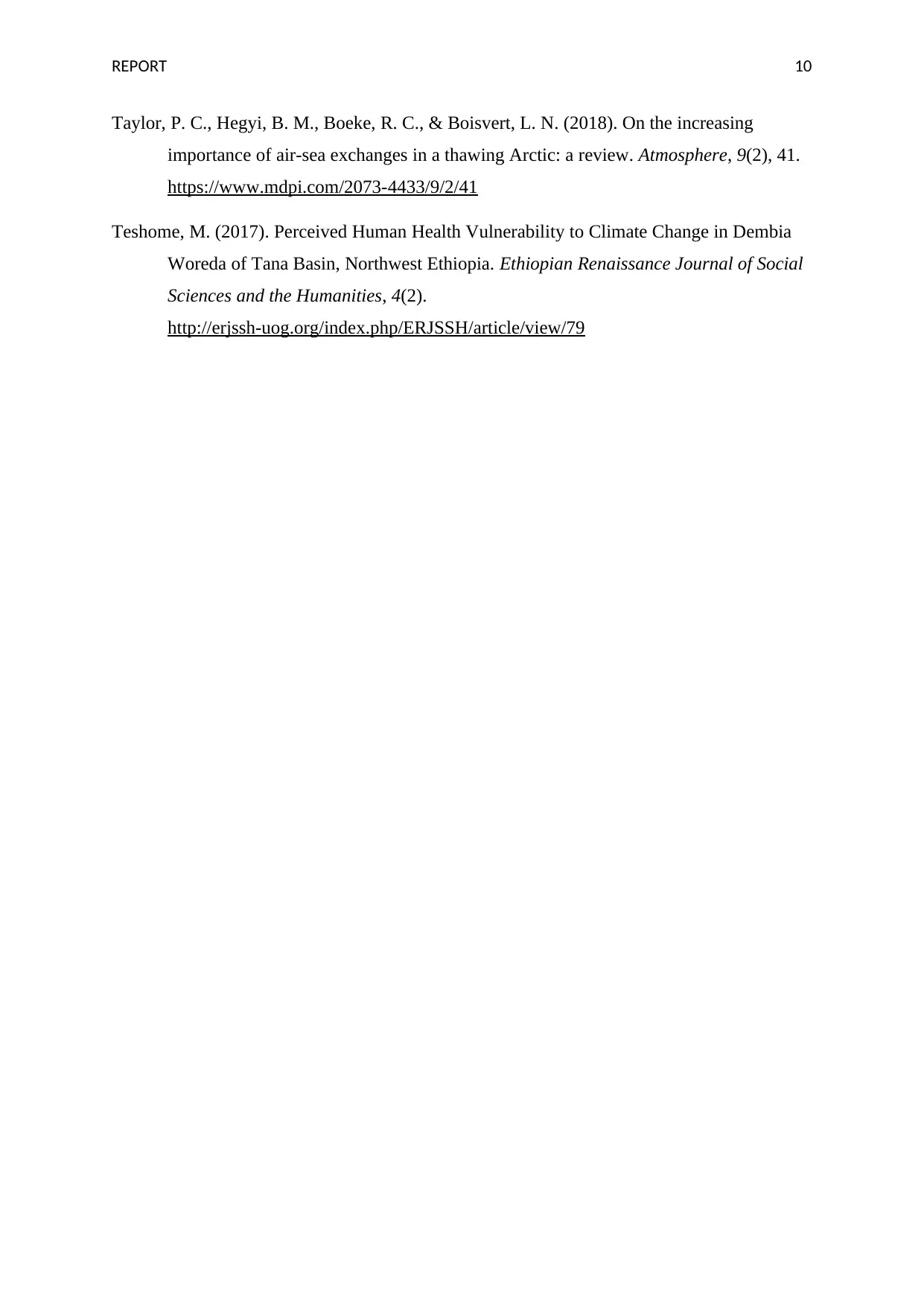
REPORT 10
Taylor, P. C., Hegyi, B. M., Boeke, R. C., & Boisvert, L. N. (2018). On the increasing
importance of air-sea exchanges in a thawing Arctic: a review. Atmosphere, 9(2), 41.
https://www.mdpi.com/2073-4433/9/2/41
Teshome, M. (2017). Perceived Human Health Vulnerability to Climate Change in Dembia
Woreda of Tana Basin, Northwest Ethiopia. Ethiopian Renaissance Journal of Social
Sciences and the Humanities, 4(2).
http://erjssh-uog.org/index.php/ERJSSH/article/view/79
Taylor, P. C., Hegyi, B. M., Boeke, R. C., & Boisvert, L. N. (2018). On the increasing
importance of air-sea exchanges in a thawing Arctic: a review. Atmosphere, 9(2), 41.
https://www.mdpi.com/2073-4433/9/2/41
Teshome, M. (2017). Perceived Human Health Vulnerability to Climate Change in Dembia
Woreda of Tana Basin, Northwest Ethiopia. Ethiopian Renaissance Journal of Social
Sciences and the Humanities, 4(2).
http://erjssh-uog.org/index.php/ERJSSH/article/view/79
1 out of 11
Related Documents
Your All-in-One AI-Powered Toolkit for Academic Success.
+13062052269
info@desklib.com
Available 24*7 on WhatsApp / Email
![[object Object]](/_next/static/media/star-bottom.7253800d.svg)
Unlock your academic potential
© 2024 | Zucol Services PVT LTD | All rights reserved.





